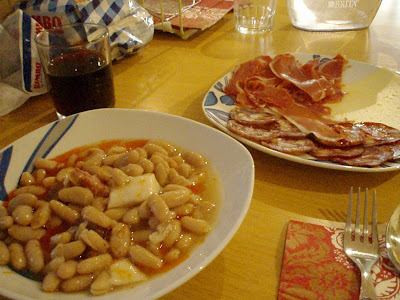Before going to Italy myself, my idea of a typical Italian meal was a giant plate of limp, squishy spaghetti, smothered with red sauce and accompanied by a meaty hunk of chicken parmigiano. Big mistake. Fortunately, I learned quickly that there are countless varieties of food native to a country’s gastronomic heritage that never makes it to the States. Even better, I discovered that a lot of our culinary stereotypes are just that: stereotypes. Like a caricature, the dishes will have aspects of authenticity to them, but are blown out of proportion and exaggerated. While I’m not saying that this is wrong—I’ve had many delicious encounters with Chicken parmigiano--I do believe that it is beneficial to understand the differences. Besides, is there ever a problem with trying new food?
After doing a little research into the dilemma of authenticity I discovered that most of what we think is the quintessential food of another country is really just the cheapest, i.e. peasant food. After hearing that a person could eat for a week in Thailand for the price of a large pizza in the states, I did some reading and found that a full Pad Thai dinner from a street cart in Bangkok tallies up to less than one American dollar. If you happen to live in England where the Sterling Pound is an economic behemoth right now, you could eat like a Thai king all day.
Think about it: rice and beans, tacos (which traditionally were made with tongue, the “throw away” meat), Beouf Bourignon (beef stew made with tough, inexpensive cuts and one of France’s most readily available ingredients—wine), Kapusta (better known as sauerkraut) and pizza (no explanation needed). All of these dishes scream their heritage yet all are easy and cheap to make. Just because Italians eat lots of pizza or the polish eat lots of sauerkraut doesn’t mean that those countries are filled with only those foods.
Ask any student who has traveled abroad what they want to eat and they will all say the same thing—whatever is native to that country. While this makes sense it isn’t as easy as it sounds. How often do we eat “American food” while we are in the states? When every street has a pizza parlor, a sushi joint and a kebab house, what is “authentic” becomes difficult to answer.
So what will I do about this nagging question? Since I’ll be in Spain for almost half a year, I decided I’d have more than enough time to “research” the facts. I started last week at the Mercat Central and I plan on keeping up my rigorous study. In addition, my living arrangements allow me fly-on-the-wall access to a common Spanish diet, so I will make sure to take full advantage of my situation.
To start things off, I present this photo of my lunch the other. A simple bean soup with Chorizo and what I found out was pure pig fat, accompanied by a plate of ham, sausage and cheese and a glass of wine.

I have lots of research to do.

No comments:
Post a Comment